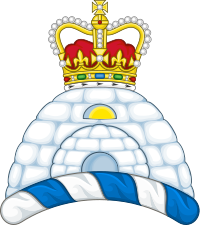|
Coat of arms of Nunavut
The coat of arms of Nunavut was granted by a warrant of Roméo LeBlanc, Governor General of Canada, dated 31 March 1999, one day before the territory of Nunavut, Canada, was created. The same document specified the flag of Nunavut. OverviewThe symbol was designed in collaboration with Inuit elders, leaders, artists, groups, and the general population of the territory. Each symbol was chosen individually from the 800 submissions for the flag and coat of arms that were received. Five draft designs were created in collaboration between the heraldic artist at the Canadian Heraldic Authority and Andrew Qappik, an Inuit artist from Pangnirtung. The shield is blue and gold, symbolizing the riches of the land. According to the blazon, the shield should be presented on a roundel shaped shield, rather than the traditional escutcheon shape in European heraldry. In chief is a representation of the midnight sun and of the North Star, or Niqirtsuituk. Below are a qulliq, a stone lamp representing the warmth of home and community, and an inukshuk (inukhuk, inuksuk), a stone monument serving as a guidepost and a symbol of the territory. The crest, an igloo (iglu), represents traditional life, survival, and the Nunavut government assembled in the legislature. It is ensigned with a crown representing royal sovereignty. The supporters, a caribou and narwhal, represent sustenance and natural resources of the land and sea. They stand on a compartment with Arctic poppies, dwarf fireweed, and Arctic heather, alongside an iceberg at sea. The motto, written in Inuktitut syllabary, is Nunavut Sannginivut (ᓄᓇᕗᑦ ᓴᙱᓂᕗᑦ, or, Our Land, Our Strength). The letters patent are quite unique, having been presented in English, French, Inuktitut, and Inuinnaqtun. BlazonHeraldic blazon describes the coat of arms of Nunavut as:
Gallery
See also
External linksWikimedia Commons has media related to Coat of arms of Nunavut.
Information related to Coat of arms of Nunavut |
||||||||||||||||||



